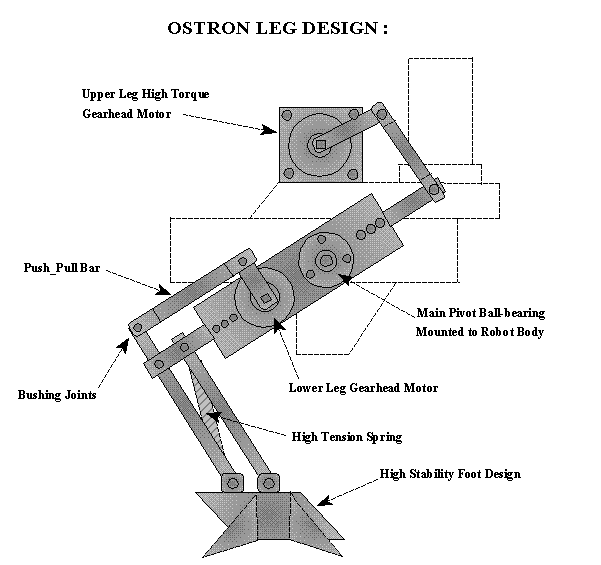| OSTRON Leg Design: |
| Below is a CAD drawing of one of the legs for my bipedal robot OSTRON. I named it Ostron because it was based on the physique of an Ostrich and merged with electronics. I've tried many different configurations for the legs and all seem to have basically the same problem that being able to lift the weight of the body. Ostron weighs in at about 15 pounds so far and its expected to exceed about 20 pounds when everythings added. Taking this into consideration and that the robot must have the ability to stand on one leg, it is appearantly obviouse that the legs must be structurally strong and deliver quite abit of lifting power ( Not to mention balance). |
 |
| Design Overview: |
| Because of the design of the lower leg with two parallel bars, the foot will stay fairly parallel with the ground. The toes of each foot is so designed as to spread out the weight of the body and thus give very stable balance. The high tension spring located between these parallel bars act to try to pull the leg straight which assists the motors for lifting and resists the legs from being flattened. This leg design with a ball- bearing pivot joint in the center with drive motors at the ends uses the mechanical advantage of the simple lever. Trying to drive the legs directly from the output shafts of the gearhead motors alone proved disastrouse. Although this design can handle the weight of the robot quite well it as added more complexity to the walking algorithm ( or set of rules to be followed for solving a problem in a finite number of steps). |
| Construction: |
| To keep the weight down all the parts, other than the motors and shafts, were constructed from aluminum. As an added bonus ( for those who have built robots before) to keep the cost down i scavanged parts from such things as discarded VCRs, typewriters, photocopiers, scanners, stereos, computers...you name it. I've went to local garage and yard sales just to see if there was anything suitable for robotics( I guess we robot builders are a peculiar breed). The main pivot joint on each leg are VCR videohead drums and bearings. The main gearhead drive motors came from an old photocopier. The legs were made from aluminum channel stock. The parts for each foot were fabricated from aluminum channel stock and sheet aluminum which was cut and bolted together. the design of the foot is sort of a fan shape (when viewed from above) to distribute the weight and to give the robot static balance when standing still. |